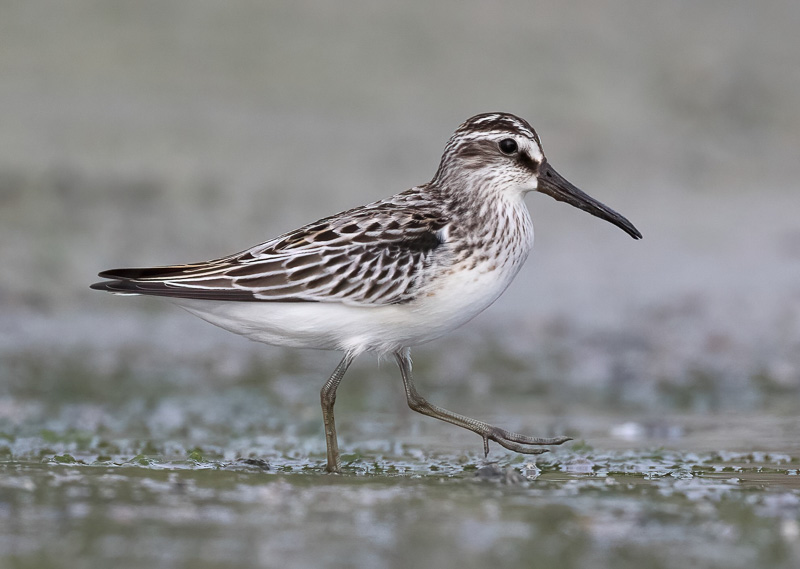Broad-billed Sandpiper Calidris falcinellus 闊嘴鷸
Category I. Passage migrant, uncommon in spring and scarce in autumn, and rare winter visitor to intertidal mudflats of Deep Bay.
IDENTIFICATION

Apr. 2019, Michelle and Peter Wong. Breeding plumage.
16-18 cm. Small sandpiper with fairly long broad bill that is obviously decurved in its distal third. Legs are relatively short and black, while a split supercilium is usually fairly obvious against rather dark lateral crown stripes, lores and ear coverts. In breeding plumage has chestnut fringes to upperpart feathers and tertials.

Sep. 2022, Sarawak, Malaysia. Dave Bakewell. Juvenile.
Juveniles have broad pale fringes to the upperparts and lack the strong chestnut tones of spring adults.

Sep. 2022, Sarawak, Malaysia. Dave Bakewell. Non-breeding plumage.
Birds in winter plumage are relatively plain grey above but retain the well-marked head pattern.
VOCALISATIONS
The typical flight call is a low-pitched, trilling, flat or slightly inflected ‘chreep’.
DISTRIBUTION & HABITAT PREFERENCE
Most records are from the intertidal mudflats of Inner Deep Bay and adjacent roost sites at Mai Po NR. Very few have been recorded on commercial fish ponds. There are fewer than 30 records since 1972 away from Deep Bay; these have occurred at Kai Tak, Sai Kung, Shuen Wan and on Lantau.
OCCURRENCE
Broad-billed Sandpiper is primarily a passage migrant through Hong Kong with most birds occurring spring, lower numbers passing through in autumn and occasional birds wintering.
Due to overlap with wintering birds it is difficult to be sure when the earliest spring migrants arrive, but it appears to be early March; in most years birds that are undoubtedly on passage are noted from the middle of the month.
Figure 1 illustrates the pattern of occurrence between mid-March and mid-November as measured by standardized shorebird counts since 1998. Most birds occur during the second half of April and first half of May, with the peak week being the first one of May. A sharp decline in numbers takes place in the second half of May.
There appears to have been a decline in the number of birds passing through in spring. Figure 2 illustrates peak counts in spring and autumn since systematic shorebird counts commenced in 1998 and indicates no obvious change in spring, with most counts lower than 150 and below 100 in 14 out of 23 years. In contrast, during the period 1986-97, when there was similar access to the intertidal mudflats but no systematic counts, two-thirds of peak counts were over 150, with the highest being 320 on 16 April 1988, 300 on 1 May 1988 and 250 during 10-11 April 1992.
There have been three records in June (from 8th to 16th in 1980, 1988 and 2018). Though there is one record in the first week of July, return passage appears to commence around the middle of the month, but it remains weak. Main passage occurs in the last three weeks of September, though numbers are substantially lower than spring. The highest autumn count this century is 40 on 19 September 2002, which compares unfavourably with the two highest count of the 1990s: 100 on 20 October 1991 and 80 on 1 October 1993.
Birds with leg flags are usually from northwest Australia; in addition, on 23 April 2021 a bird was present that bore a leg flag attached at Point Calimere, South India on 7 October 2019.
BEHAVIOUR, FORAGING & DIET
Forages on intertidal mudflats in a rather slow manner occasionally probing but more usually picking at surface of substrate.
RANGE & SYSTEMATICS
Two subspecies are recognised: C.f. sibirica breeds in northeast Siberia and passes through most of Asia, including HK, to winter from northeast India to Australia. The nominate breeds from north Europe to northwest Siberia, and winters from the Middle East to southern India (Van Gils et al 2020). In China it is a passage migrant through much of the country and small numbers winter along the south coast (Liu and Chen 2020).
CONSERVATION STATUS
IUCN: VULNERABLE. Population decreasing by approximately 30% over three generations.
Figure 1.

Figure 2.

Liu, Y. and Y. H. Chen (2020). The CNG Field Guide to the Birds of China (in Chinese). Hunan Science and Technology Publication House, Changsha.
Van Gils, J., P. Wiersma, and G. M. Kirwan (2020). Broad-billed Sandpiper (Calidris falcinellus), version 1.0. In Birds of the World (J. del Hoyo, A. Elliott, J. Sargatal, D. A. Christie, and E. de Juana, Editors). Cornell Lab of Ornithology, Ithaca, NY, USA. https://doi.org/10.2173/bow.brbsan.01

